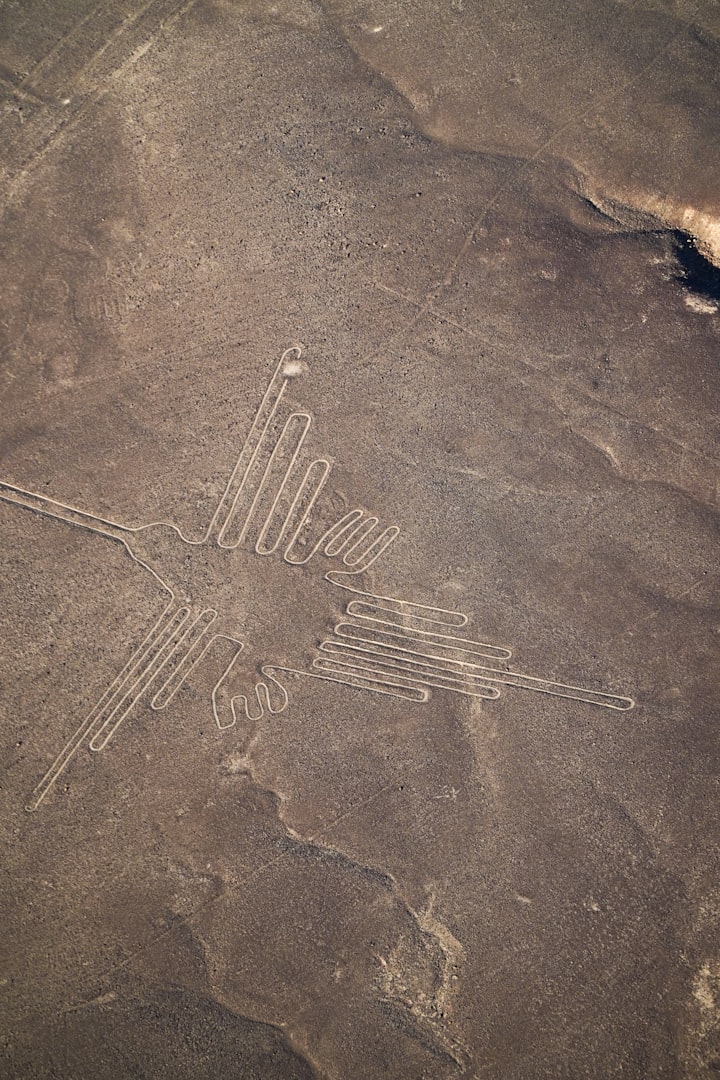A Mysterious Ancient Art in the Nazca Desert of Peru
A prehistoric site which represents the creative mastery of Nazca people

The Republic of Peru is the 3rd largest South American country. It is located on the coast of Pacific Ocean. Peru has inherited a mysterious, stunning and artistic creation from ancient culture.
These mysterious structures are called the "Nazca Lines''. These ancient Nazca Lines have fascinated the people throughout the world for centuries. This site is located in the vast, hot and dry desert of southern Peru.
Nazca people have carved these artistic designs on barren landscapes. This prehistoric site represents the creative mastery of Nazca people. Researchers have struggled to find out how these earthly designs were created. Tourists wonder at these huge and beautiful structures.
What are Nazca Lines?
The Nazca Lines are a series of gigantic earthly designs that includes basic geometric shapes to delicately carved out representations of humans, plants, animals and abstract designs.
The Nazca civilization which existed between 500 BC and 500 AD made these amazing earthly designs. The site covers an area of 450 square kilometers. The smallest structure is a few feet in length. The greatest of these magnificent structures stretches for a length of 1200 feet.
The site is known as one of the most mysterious archeological sites in the world. This proves the extraordinary perfection and artistic skills of the prehistoric Nazca community.
Researchers believe that these artworks were created on the lighter-coloured earth. And this desert surface was once covered with reddish-brown, iron oxide coated pebbles which were removed.These structures have existed for thousands of years. Researchers are focusing on the techniques and tools employed by Nazca civilization to carve out these enormous geoglyphs.
Why were Nazca Lines created?
Scientific research on Nazca Lines has not been able to come up with an explanation on the purpose of such huge structures and it still remains unknown. Others contend that the geoglyphs were of a religious or spiritual nature and that they were used to communicate with the gods or to direct ritual processions. One such theory even goes to say that these were landing strips for alien spacecraft!
The Nazca Lines may have been utilized in ceremonies involving water and agriculture, according to one widely accepted idea. Researchers think Nazca civilization depended on irrigation to survive in the dry desert environment. And these lines may have served as routes for ceremonies and processions during dry spells. This could have been a method to pray to the gods for rain and abundant crops.
The Nazca people's respect for nature and reliance on animal husbandry have also been connected to the elaborate drawings of creatures including spiders, hummingbirds, and llamas (a domesticated animal of the camel family), monkey, whale, and condor (Vulture). But there is no concrete scientific evidence to prove any of these theories.
Scientific research on Nazca Lines:
The exact meaning of the Nazca Lines has remained elusive despite numerous theories being put up over the years. The Nazca civilization's lack of written records makes it more difficult to understand their intentions, as it does with many other ancient mysteries. Nevertheless, the Nazca Lines' have always ignited fascination among explorers and academics in the world and encouraged to take up research using advanced technology in the area of archaeology.
Researchers, today, are using advanced technologies like drones and satellite photography to capture the entire structures and learn minute details of their designs. The technology has helped researchers to accurately measure these artistic lines. Researchers have also stumbled upon new geoglyphs, which were previously unknown. So research on Nazca lines has helped enhance our knowledge about these ancient structures, and at the same time, put up new challenges on their origin and meaning.
A Popular tourist destination:
The site of Nazca Lines attracts tourists from all over the world. This popular tourist destination is in a remote area of Nazca desert. Tourists can visit the place by plane or by helicopter. Tourists can also get a view of these lines from a nearby hilltop, though the view will not be so clear.
UNESCO has recognised Nazca lines as a World Heritage Site. The government of Peru oversees the administration of this historical site, including its preservation. However, they are also threatened by development, erosion, and vandalism activities. In recent years, efforts to raise awareness about the importance of the Nazca Lines and the need for preservation for future generations have picked up.
Those who wish to visit the Nazca Lines have to find a reputable tour operator. There are different tour packages available. The cost of the tour varies according to the length of the tour and the type of transportation.
So, the Nazca Lines of Southern Peru's desert is a testimony to ancient engineering skills and an unending mystery that has captured the attention of people all over the world. The enormous size, intricate craftsmanship, and unexplainable function of these structures make us wonder how an ancient civilization produced such huge timeless artwork. This UNESCO world heritage site attracts a huge tourist crowd every year. These mysterious geoglyphs remind us of the vast mysteries still hidden from us and the endless wonders of our common human history.
The Nazca Lines symbolize human ingenuity, inventiveness, and the never-ending desire to leave an impression in this world as we move on with the new discoveries. These ancient geoglyphs' mystery encourages us to recognise the life, ideals, and goals of a civilization. This leaves us thinking how the past and present are intertwined often in an inspiring and unexpected way.
About the Creator
Yateen Jakati
A science graduate and passionate about science, technology and environment. Like Indian classical music.
https://www.facebook.com/yateen.jakati.5






Comments
There are no comments for this story
Be the first to respond and start the conversation.